Spatial Relations in Early Math Transcript
Allyson: My name is Allyson Krogmann-Jordan, I am an early learning coach for Santa Monica-Malibu School District. I help teachers when they have questions about how to implement certain strategies or they want to reflect on their current practices. Today's focus is on spatial relations. We work on having children look at an image and we describe where things are on the page in relation to one another, we talk about size and spacing. So today we went into a preschool classroom, which is comprised of 3 and 4-year-olds, and a TK classroom, which is a transitional kindergarten classroom, specifically for children that turn 5 years old between September 2nd and December 2nd.
This story is called "There's a Bear on My Chair." See that bear?
I began today's lesson by introducing the story, and I read the story from start to finish.
"When I give him a nasty glare, he seems completely unaware. I don't know what he's doing there, that bear who's sitting on my chair."
Child: You need to share.
Allyson: Periodically throughout the book, I would stop to ask them questions about the things that they saw on a page.
"Do you remember this page from the story?"
Children: Oh yes. Um hm. He's pushing him off.
Allyson: What do you notice? Raise your hand if you can share with me? Tyler, what do you notice?
Tyler: He's pushing like this.
Allyson: Oh my goodness. Can you show me, everyone show me what that looks like. Pushing.
On the page, the mouse is pushing the polar bear, and so we talked about how do you show pushing.
What will happen to that bear if he keeps pushing? Raise your hand if you can share with me so I can hear your ideas one at a time. Moises, what do you think?
Moises: He will fall down.
Allyson: Where will he fall down?
Moises: In the floor.
Allyson: He'll fall on the floor. So will he fall forward or will he fall backwards?
Children: Backward.
Allyson: Once we started to talk about would he move backwards, would he go forward, and the children started to do that. And so we practiced moving our bodies back and forward and then straight.
Can you show me with your bodies leaning back?
From there they were able to hear the language, they did it, but then they were able to respond to that original question that I asked, which direction would the bear move?
Who can tell where is the chair in this picture?
In today's lesson, I took some of the elements, some of the characters from the story and I put them up on the Smart Board just to kind of get them engaged and using that vocabulary.
Where is the angry mouse in this picture?
Speaker 6: He pushing the bar.
Allyson: Where is the angry mouse?
Speaker 7: He's right there.
Allyson: Um hm. What words could you use to tell me?
Speaker 7: He's at the bottom.
Allyson: A lot of times young children like to say, "Right there," and they point. We want to pull out that language and the vocabulary so that they are explaining where things are in relation to one another.
So you're gonna think about those things when you go back to your seat to draw this whole page as best that you can.
And then from there children go off and work on replicating or drawing that same image. Teachers, we navigate through the room and question and probe children on how they're positioning things on their page while they're drawing in relation to the image that they're seeing.
Speaker 8: I need to use a big paper 'cause I want to do more stuff over here. I have a square.
Speaker 9: What is that?
Speaker 8: Chair.
Speaker 9: What is that?
Speaker 8: Chair.
Allyson: So tell me again why you chose that paper?
Speaker 8: Because I'm gonna put in more details over here.
Allyson: What details will go over there? What do you see?
Speaker 8: I'm gonna put in the tail.
Allyson: That tail of what animal?
Speaker 8: The mouse, because he's too long.
Allyson: Where do you think that mouse will go? Can you show me?
Speaker 8: Next to the [crosstalk 00:04:13].
Allyson: And where will the bear go?
Speaker 8: [crosstalk 00:04:13].
Allyson: Can you tell me about what you're drawing?
Speaker 9: I'm drawing a polar bear.
Allyson: I always like to take notes of the conversations that I have with children, because I can't remember it all. But they have a lot of really wonderful and valuable things to say. The other important thing about documenting and taking notes is that it gives me something to go back to and refer to when I'm trying to plan for the next activity.
Can you tell me about this part?
Speaker 10: This part is the pillow and over here is the plate you sit on.
Allyson: So where is the pillow?
Speaker 10: Here.
Allyson: Where? Tell me with your words.
Speaker 10: Over here.
Allyson: I see that you're pointing, but can you tell me with your words where the pillow is?
Speaker 10: It's on the chair.
Allyson: It's on the chair. I think questioning is one of the most difficult things that you learn to do as a teacher. When you start, you have no idea what questions to ask, or you'll have a really great question and then you just can't think of a followup question. And so it's a skill that kind of develops over time, but I think the most important part of questioning is just sitting and listening to the children.
So tell me what part you're working on right now.
Speaker 11: The bear.
Allyson: The bear. Where is the bear on your paper?
Speaker 11: On top of the chair.
Allyson: Okay. Is the bear on top of the chair in that picture? Okay. What is next to the bear in that picture?
Speaker 11: The mouse.
Allyson: So what will be the next part? What else do you have on your paper or on your page to add?
Speaker 11: The mouse.
Allyson: So where will the mouse go?
Speaker 12: Qué piensas Mateo?
Speaker 13: Biene. Los orejas.
Speaker 12: Tiene orejas arriba. Okay. Que esta pasando abajo? Que esta pasando?
Speaker 13: He's pushing [inaudible 00:05:47].
Speaker 12: Quien?
Allyson: Edison Learning Academy is a Spanish immersion program. The children speak 90% Spanish and 10% English. When I am in the classroom, I don't speak Spanish, so I am their 10% English, but ideally all of these lessons are happening in Spanish.
Speaker 12: Que parte del osito esta arriba? Que es esto keosa arriba?
Speaker 14: El ojos.
Speaker 12: Los ojos. Okay. Quien esta aqui?
Speaker 14: The little mouse.
Speaker 12: El raa-o-- Como seama? El-?
Speaker 14: Raton.
Speaker 12: El raton.
Allyson: Another way to enhance the work that we're doing with spatial relations is around block play. And so we did an activity today where children each had a given set of blocks, they all had the same blocks. We started with three today.
So I'm going to build a structure and then I'm going to explain to you how to build exactly what I have, and I'm gonna see if you can match. You think you can do it? Okay, let me build.
Child: But don't trick us.
Allyson: Oh, I'm gonna try to trick you.
Child: No.
Allyson: I'm gonna try.
Child: I'm not gonna do it.
Allyson: So you'll have to do your very best listening.
The role of the person that's the lead builder is to use their language to describe exactly how they made their structure, so that the rest of the children can recreate of replicate that same structure.
Tell us with your words how you built your structure. Let's see if we can build the same. Tell us where your blocks are.
Speaker 15: The little one is the little square one is on laid down on the bottom.
Allyson: Okay.
Speaker 15: And the rectangle is on top of it.
Children: I know where rectangle. Like this.
Speaker 15: On top of the side of it.
Children: Is it like it? Is it standing up or laying down?
Allyson: Can you describe it again for us?
They have to use really precise language, they have to really think about what spatial relations vocabulary they're using.
Speaker 15: The cylinder is on the bottom.
Speaker 16: Of what?
Speaker 15: Touching the bottom of the ... Laying down of the bottom on the rectangle.
Speaker 16: Oh, like this?
Allyson: As we started to move on with this activity, the children stared to create these really elaborate ways of placing the blocks and that are really complicated to describe.
Speaker 17: The rectangle is on top of the cylinder.
Children: On top of the cylinder.
Allyson: Today I noticed the children were placing blocks diagonally.
That was hard to describe, how this block was laying, wasn't it? Because it was not all the way on top of the square block, but it was also touching the ground. So it's kind of diagonal. You see it's not a straight line.
Through this whole process the goal is that children are learning and growing, but because these activities require the teacher to be so reflective, what ends up happening is I end up learning just as much as the children about how children learn, and about how I am as a teacher, and how to refine my own practice.

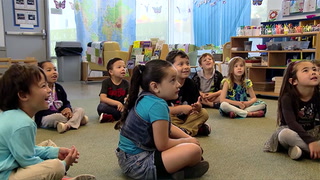

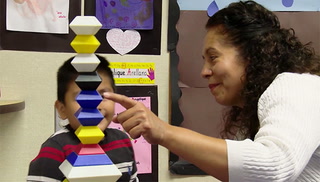
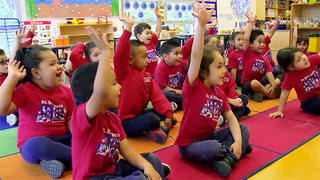

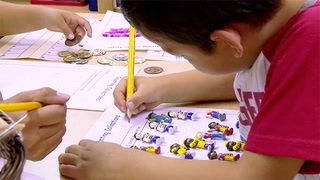
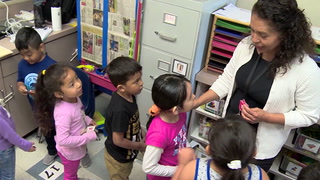
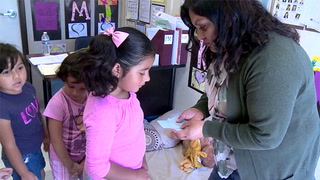
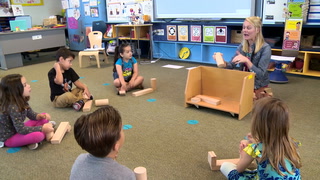


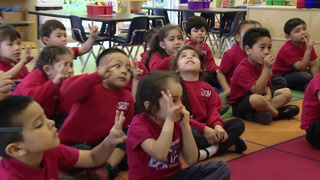









2 Comments
Cade Patterson Aug 27, 2019 10:41pm
This is a great strategy for kinesthetic learners weather it is in early grade school or in higher grade levels. Now saying this the strategies will be different depending on the grade level but it is important to get students involved in the lesson and find ways for them to think deeper. This is a great video!
Rosemarie McFat... Jan 31, 2018 12:51pm